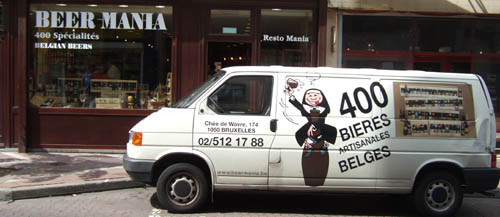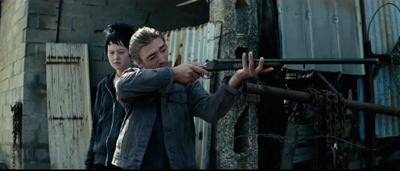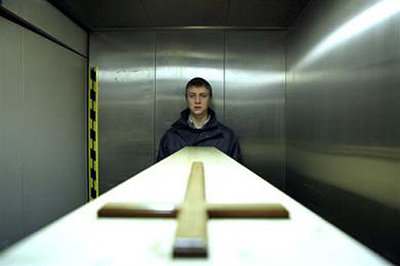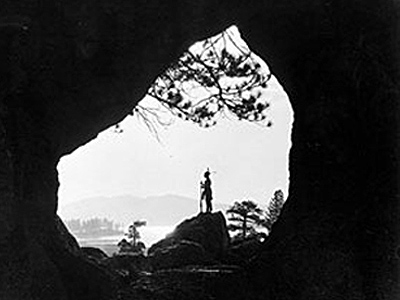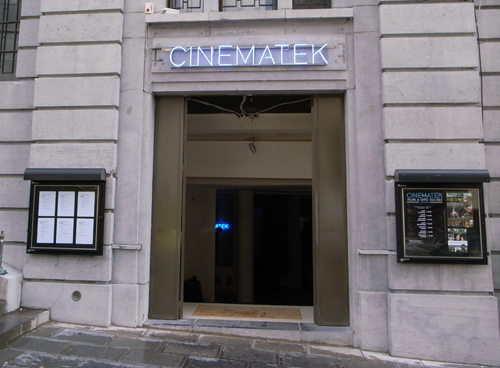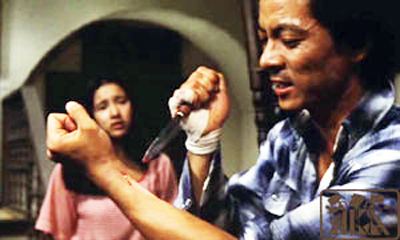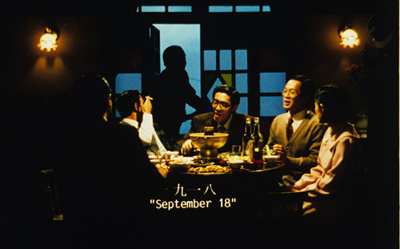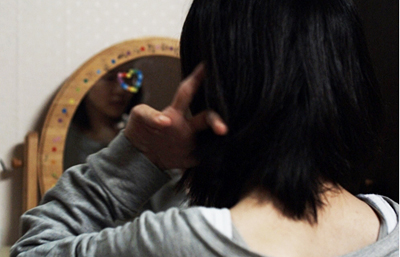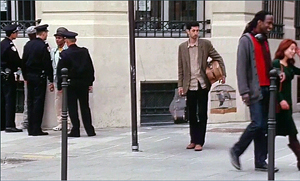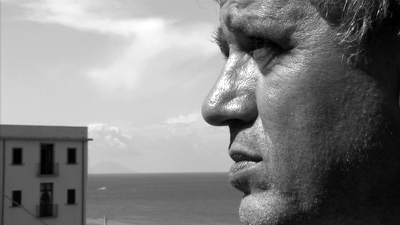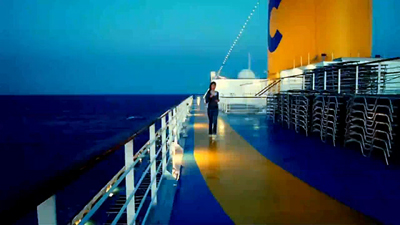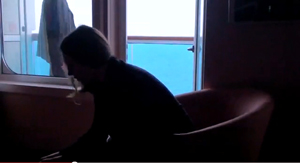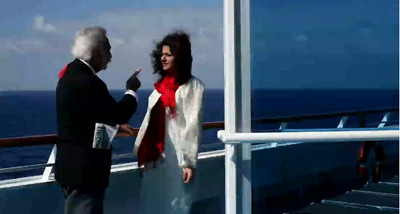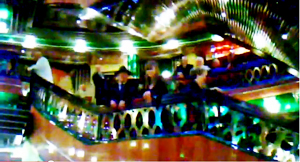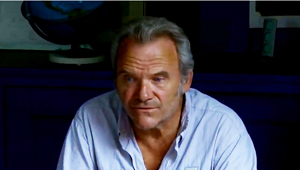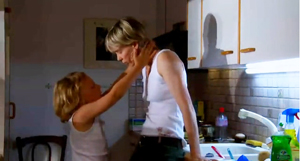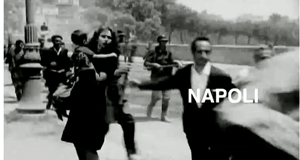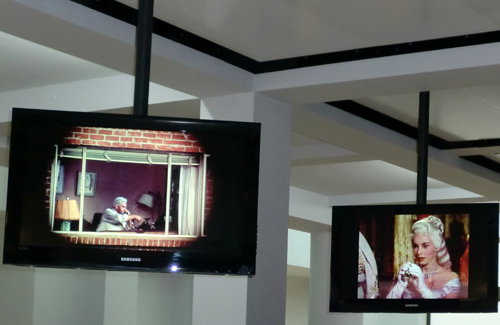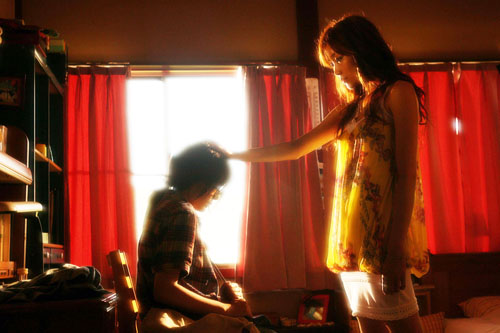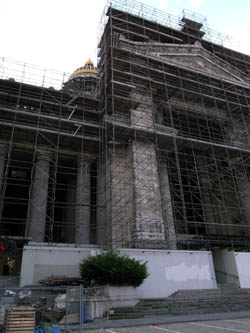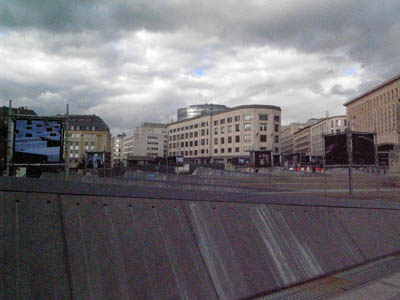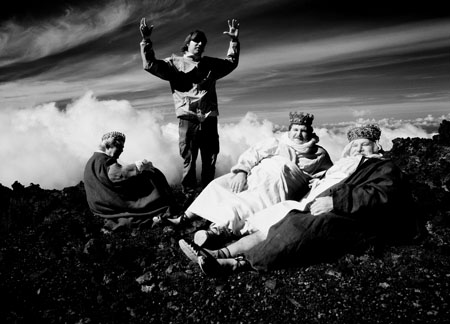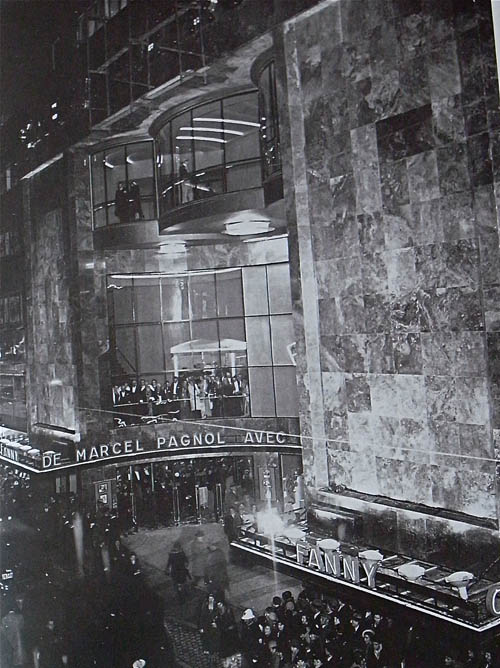Archive for the 'Festivals: Cinédécouvertes' Category
If it’s Tuesday, this must be Belgium, if it’s July
The entrance to the Brussels Cinematek screening rooms. No cellphones, no drinks, and above all no frites.
DB here:
As every year, I’m spending time in Brussels doing research at the Royal Film Archive, and as usual every two years, I’m preparing to go to the Flemish Film Foundation’s Summer Film College, this time in Antwerp. My stay was timed, also as usual, to the Cinédécouvertes festival sponsored by the Cinematek.
Cinédécouvertes is a partly a festival of festivals, gathering most of its titles from Venice, Rotterdam, Berlin, and Cannes. It’s a good way for me to catch up with several top-flight films unlikely to come to the US, or at least any time soon. (See the links at the bottom of this entry for my earlier observations.) In screening only films that have not been bought for Belgian distribution, Cinédécouvertes’ record shows a keen talent-spotter’s eye. Just in the last ten years, its winners have included Japón, Oasis, Shara, Tropical Malady, Day Night Day Night, How I Ended This Summer, and Police, Adjective. The year 2000 was remarkable, with prizes given to four films: Miike’s Audition, Im’s Chunhyang, Kurosawa’s Barren Illusion, and Tarr’s Werckmeister Harmonies. My affection for this modest but robust festival goes back to the 1980s; it introduced me to films by Hou, Kitano, and Kiarostami when they were genuine cine-discoveries.
This year Bruno Dumont’s Hors Satan took the L’Age d’or prize, the one reserved for films that seek to disturb us in the vein of Buñuel’s classic. That prize consists of 5000 euros given to the filmmaker. The two other awards aim to support local distribution of the best work. The Austrian entry Atmen (Breathing) by Karl Markovics and Alejandro Landes’ Porfirio, set in Colombia, won the prizes. If either is picked up for Belgian release, the distributor will receive 10,000 euros to help cover costs. Shouldn’t other festivals imitate this strategy for getting films onto screens?
My lecture preparations for Antwerp kept me away from many festival offerings, but I did see two of the prizewinners. Atmen and Hors Satan reminded me that a lot of European art films, despite their reputation for being slow, have a crisp, laconic style. Abrupt cuts open and end scenes, while an unexpected close-up can accentuate a moment. This sort of precision meshes with other conventions of this tradition: delayed exposition, long scenes without dialogue or music, routines that structure the plot, and a demand that we let things unfold at a rhythm different from that of the goal-driven Hollywood cinema. Early on, the scruffy idler of Hors Satan shoots down a man while the vaguely punkish girl with him doesn’t bat an eye. What registers is the bare, brute act, no more and no less.
Eventually we’ll learn some causes and reasons, but in this mode of cinema, a gesture is given heft by coming out of nowhere, without benefit of much preparation. What we can count on is the repetition of a routine, such as the man’s praying or his receiving a piece of bread each day from an (initially) unseen donor. Sooner or later, something will emerge–a pattern of activity, if not a straightforward plot.
Similarly, we know almost nothing about the young man who gets dressed at the start of Atmen. Only gradually will his routines reveal his work-release from a juvenile prison and his growing awareness of his responsibility for the crime that put him there. In this unvarnished tale, which sends young Vogler to work assisting a mortician, we get nothing like the mixture of humor and poignancy we find in Takita’s Departures. Everything here is cool, even curt, with each shot providing a bit of action that we have to fit into the personality lurking behind Vogler’s guardedly blank expression.
That personality becomes clear, in a rather conventional way, when Vogler sets out to find the mother who abandoned him. Things are much more opaque in Hors Satan, in which miracles and near-miracles are performed with a grimy physicality suited to provincial life lived among marshes and rocky hillsides. If Atmen pulls into focus as a fairly clear-cut psychological drama, Dumont’s film tries for something grander and less committed to personality. It seems to me to aim for a sense of flinty, rough-hewn holiness that is beyond conventional piety. In The Tree of Life, faith bathes the lovely faithful in a glow–hell, it can make them levitate–but here faith, if that’s what’s involved, is irredeemably coarse, even ugly. (Hors Satan reminded Cinédécouvertes judge Charles Tatum of Abel Ferrara.) Like Atmen, though, Hors Satan gets to its destination through a storytelling technique that we can trace back to neorealism and its respect for dawdling exposition and the undramatic singular detail. Some cinematic traditions are endlessly fertile.
Earnest Goes to Summer Movie Camp
The Last of the Mohicans (1920).
This year’s July film college is woven of three strands. One is called “Masterpieces in Context,” and it includes films by De Sica, Ford, Flaherty, and others. The primary strand is devoted to film and the visual arts, and given my interests it looks exciting. Steven Jacobs will present lectures related to his new book, Framing Pictures, to be published during our event. Steven will survey a range of relationships between cinema and painting, including films about artists (e.g., Caravaggio) and scenes set in museums. Wouter Hessels, the incoming Director of the Cinematek, will discuss work by André Delvaux and other Belgian filmmakers. Lisa Colpaert will talk on “Noir Portraits.” And Tom Paulus will survey instances of the influence of painting and photography on directors’ visual style, ranging from Tourneur to Tarkovsky. Films include The Last of the Mohicans (1920), Spirit of the Beehive (1973), and Arsenal (1929). I’ll throw in my $.02 with a lecture called “Seeking and Seeing: Lessons from E. H. Gombrich,” which hopes to show how Gombrich’s approach to art history can help us study film history.
My main contribution, though, is to a third strand called “Dark Passages: Storytelling in 1940s Hollywood.” Through screenings of Suspicion (1941), Daisy Kenyon (1947), Laura (1944), A Letter to Three Wives (1948), and six other movies, I’ll survey some narrative innovations of this remarkable era. Our main attractions are A pictures, but I’ve pulled some clips and stills from B’s, which are no less intriguing in their flashbacks, dreams, hallucinations, splits in point-of-view, and treatments of mystery and suspense.
I’m still working on the talks, but what’s emerging is one unorthodox premise. As an experiment in counterfactual history, let’s pretend that World War II hadn’t happened. Would the storytelling choices (as opposed to the subjects, themes, and iconography) be that much different?In other words, if Pearl Harbor hadn’t been attacked, would we not have Double Indemnity (1944) or The Strange Affair of Uncle Harry (1945)? Only after playing with this outrageous possibility do I find that, as often happens, Sarris got there first: “The most interesting films of the forties were completely unrelated to the War and the Peace that followed.” Sheer overstatement, but back-pedal a little, and I think you find something intriguing.
Some lectures are in English, some in Dutch. All screenings are 35mm, with live accompaniment for the silent films. There will also be an excursion to Antwerp’s gorgeous, widely praised new museum, the MAS. It’s open until 11 on weeknights and until midnight on weekends, an admirable idea. I’ll be sure to take photos of the skull-mosaic terrace.
More on the summer film school after I’ve done it. In the meantime, coming up blog-wise: ideas about how people might have watched movies a hundred or so years ago.
I first explained my research in the film archive here. For previous years’ notes on the Cinematek’s annual festival, you can go to the category here. On the Cinephile Summer Camp, here is the report on the 2007 gathering and here’s the one on 2009. Sarris’ scandalous claim (yes, I too thought about The Best Years of Our Lives, They Were Expendable, Ministry of Fear, etc. etc.) is in the introductory essay, “Toward a Theory of Film History,” in his classic book The American Cinema (New York: Dutton, 1968), 25.
I especially believe the “with all present” part. This is apparently the table to get at Au Vieux St. Martin, Brussels. In reflection is Nicola Mazzanti of the Royal Film Archive.
Ledoux’s legacy
DB here:
Every summer Brussels hosts one of the world’s most unusual film festivals. By global standards it’s a small event: it showcases only twenty or so titles, each screened twice. The films are on the whole unknown. The prizes are minuscule by the million-plus benchmarks set by Dubai and Abu Dhabi. The venue stands behind an inconspicuous doorway. Yet for me it’s an unmissable event, a crucial influence on my thinking about film and my search for cinematic satisfaction.
Jacques the gentle
Young Murderer (Seishun no satsujin sha, 1976).
Between 1948 and his death in 1988, Jacques Ledoux was the curator of the Royal Film Archive of Belgium. He made it into one of the cinema’s legendary places, at once Mecca and Aladdin’s cave. On remarkably small budgets, he assembled broad and deep collections. He bought many titles for distribution to local cinemas and schools. He created a public screening program that for decades has shown five different films (two of them silents), every day of the year. The year Ledoux died he received an Erasmus Prize for his services to European culture.
His early life could have come out of an East European movie. Born in Poland in 1921, he fled to Belgium to escape the German onslaught. He hid in several places, including a monastery. There the abbot gave him work publishing Benedictine books. In the abbey’s screening room Ledoux discovered a copy of Nanook of the North. He offered it to the just-started Belgian Cinémathèque, and its supervisor, the filmmaker Henri Storck, offered Ledoux a job. Finding film archivery more appealing than studying science and medicine, he stayed with the Cinémathèque. Interestingly, “Jacques Ledoux” was a pseudonym; one translation is Jacques the Gentle.
Not always gentle Jacques in his scraps with other archivists and local politicians, Ledoux pledged himself to filmmakers, audiences, and—a rarity at the time—overseas film scholars. New Wave directors and Parisian critics made railway pilgrimages to Brussels to see films unavailable in France. When Kristin and I started doing research in the archive in the 1979, Ledoux welcomed us and guided us to treasures we hadn’t known existed.
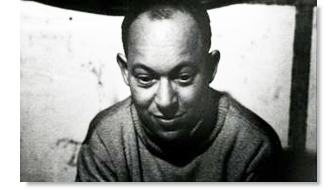 Unlike the very public Henri Langlois, Ledoux worked best behind the scenes. Probably most cinephiles today know him only from his brief appearance as one of the sinister experimentalists in La Jetée (1961). He resisted being photographed, and he refused to wear a necktie. Unsurprisingly, he admired directors who strayed from the beaten path. He created the first festival of experimental cinema at Knokke-le-Zoute, in 1949.
Unlike the very public Henri Langlois, Ledoux worked best behind the scenes. Probably most cinephiles today know him only from his brief appearance as one of the sinister experimentalists in La Jetée (1961). He resisted being photographed, and he refused to wear a necktie. Unsurprisingly, he admired directors who strayed from the beaten path. He created the first festival of experimental cinema at Knokke-le-Zoute, in 1949.
His desire to widen everyone’s knowledge of cinema found another outlet when he created the Prix l’Age d’or/ Prijs l’Age d’or in 1958. It was aimed to reward, as Ledoux put it, “a film that, by questioning taken-for-granted values, recalls the revolutionary and poetic film of Luis Buñuel, L’Age d’or.” Ledoux wanted to encourage a cinema that was subversive in both content and form.
The first prizes were given within the framework of the Knokke event: in 1958, to Kenneth Anger; in 1963, to Claes Oldenberg; in 1967 to Martin Scorsese (for The Big Shave). In 1973, the prize assumed something close to its current form. Several films were screened for the public, and the award, now in the form of cash, was decided by a jury system. The first winners were W. R.: Mysteries of the Organism (in 1973); Borowczyk’s Immoral Tales (1974); Raul Ruiz’s Expropriation (1975); Angelopoulos’ Traveling Players (1976); Hasegawa Kazuhiko’s Young Murderer (1977); and Antoni Padros’ Shirley Temple Story (1978).
The winners emerged from a vast and powerful field of competition. In 1973, the first formal year of L’Age d’or, there were sixty-nine films screened, including Aguirre, the Wrath of God, Oshima’s Ceremonies, Paul Morrissey’s Heat, Tout va bien, and works by Rosa von Praunheim, Wim Wenders, and Miklós Jancsó. There was even The Discreet Charm of the Bourgeoisie, but Buñuel didn’t win a prize named after his own film! The number of titles dropped a little as the years passed, but it’s good to know that in 1978 Assault on Precinct 13, Eraserhead, Perceval le Gallois, and films by Ruiz, Littín, and Schroeter were in the competition.
Ciné-Discoveries
City of Sadness (Hou Hsiao-hsien, 1989); screened at Cinedécouvertes 1990.
Things changed a bit after 1979. The L’Age d’or criteria were modified to identify “films that by their originality, the singularity of their viewpoint, and their style [ecriture] deliberately break from cinematic conformity.” For whatever reasons, hard-edged subversive cinema was harder to come by. In the meantime, the Prix was absorbed into a broader festival Ledoux launched in 1979, Cinédécouvertes.
Cinédécouvertes became a “festival of festivals.” It culled its selection from films that had been screened at Rotterdam, Berlin, Cannes, Venice, and other events. What set Cinédécouvertes apart was its determination to expand film culture. All the films on the program had no Belgian distribution. Each cash award (today, two of 10,000 euros each) would go not to the filmmaker but to a distributor willing to pick up the film. This is a very tangible way to help films of quality find a local audience.
Over the last ten years, Cinédécouvertes has awarded prizes to Audition, Chunhyang, Werckmeister Harmonies, Oasis, Tropical Malady, Day Night Day Night, Mogari no Mori, Afterschool, and Police, Adjective. The L’Age d’or prize has been given to Aoyama’s Eureka, Reygadas’ Japón, Encina’s Hamaca Paraguay, Balabanov’s Cargo 200, and several others. Not every film has been picked up for local distribution, but the impulse to elevate films that go beyond the obvious festival favorites has continued. Ledoux’s successor as curator, Gabrielle Claes, has maintained the legacy of L’Age d’or and Cinédécouvertes. The July festival flourishes in the Cinematek’s newly rebuilt complex and in its other venue, the lovely postwar-moderne building in the Flagey neighborhood.
The annual Brussels event helped me find my way through modern cinema. There I saw my first Kiarostami (Where is My Friend’s Home?), my first Tarr (Perdition), my first Hou (Summer at Grandpa’s), my first Oliveira (No; or, the Vainglory of the Commander), my first Sokurov (The Second Circle), my first Kore-eda (Maborosi), my first Panahi (The Mirror), my first Jia (Xiao Wu). The Cinematek’s talent-spotters were quick to find many of the most important filmmakers of the 1980s and 1990s, and I’ll be forever grateful for their acumen. After I saw these films and many others here, my ideas about cinema got more cogent and complicated. My life got better, too.
Now most of these filmmakers find commercial distribution in Belgium, so Gabrielle’s scouts must scan new horizons. This year as usual Cinédécouvertes boasted some familiar names like Iosseliani, Wiseman, Guzman, and the eternal troublemaker Godard. But there are also filmmakers from Costa Rica, Sri Lanka, Ireland, Peru, Colombia, and Ukraine. The landscape of film is vast, as Ledoux always reminded us, and a small festival can nonetheless open windows wide.
Mind games, or just games
Elbowroom.
Psychology is at the center of festival cinema. Deprived of car chases and exploding buildings, arthouse filmmakers try to track elusive feelings and confused states of mind. That this can be dramatically engaging in quite a traditional way, as was shown by one of the Cinédécouvertes winners, How I Ended This Summer.
Director Aleksei Popogrebsky puts two men on a desolately beautiful island in the Arctic. They’re initially characterized by the way they execute the routines of measuring weather conditions. Sergei, the stolid older one, is soaked in the ambience of the place, enjoying fishing and boating while insisting on exactness in the log. Pasha is a summer intern, a little careless because he’s exhilarated by the atmosphere: he’s introduced first taking a Geiger-counter reading but then hopping and racing along a cliff edge to the beat of his iPod.
Soon, though, Pasha must give Sergei a piece of bad news that comes in over the radio. Out of awkwardness, fear, refusal of responsibility, and other impulses, he avoids telling his mentor. The consequences are unhappy for each. The film takes on the suspense of a thriller, with conflicts surfacing in a cat-and-mouse game at the climax. Yet before that, more subtly, we have watched several tense long takes of Pasha’s face as he tries to cover up his failures. Not surprisingly, How I Ended This Summer won one of the two Cinédécouvertes prizes. It is an engrossing case for character-driven, locale-sensitive cinema.
Elbowroom tackles psychology from a more opaque and disturbing angle. With no exposition or backstory, we’re plunged into an institution for the handicapped. During the first ten minutes, without dialogue, a handheld camera lurks over the shoulder of a young woman who tries with twisted fingers to apply lipstick. Soon she is preparing to have sex with another inmate, and after their liaison she is whacking her feeble roommates, who sob under her blows. Eventually we’ll recognize this introduction as a summary of her days: fighting with others, being coaxed or berated by staff, meeting her lover, and taking up cleaning tasks. Only far into the film will we learn about how she got here and what her fate will be.
Soohee, stricken with cerebral palsy, is played by a young woman with a milder disease. Very often the camera doesn’t let us see her face, fastening instead on a ¾ view from behind. This seems to me partly a matter of tact, but its ultimate effect is to force us to infer Soohee’s state of mind from her behavior. The visual narration remains resolutely outside the character. Psychology gets reduced to gestures— spasmodic smearing of lipstick, the clasping of a necklace, the seizure of a baby doll (with which she’s bribed). Only at the end does a long held close-up of Soohee’s twitching, smiling face give us fairly direct access to her feelings. Despite the smile—which can be read as a sort of perverse victory for her—Soohee isn’t the noble victim; we’ve seen her petty and selfish side already.
This trip into a world most of us haven’t seen before is presented without conventional pieties, and it’s unsettling. Elbowroom, Ham Kyoung-Rock’s first feature, offers the sort of challenge to aesthetic and moral conventions that the L’Age d’or Prize was designed to encourage. The film won it.
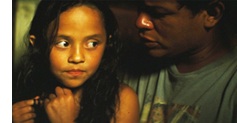 Characters’ psychological developments can also be brought out by parallel construction. A willful little girl and a scientist cross paths in Paz Fábrega’s Cold Water of the Sea. Karina is on a beach holiday with her family and insists on wandering off at intervals. Marianne is a medical researcher, here for a vacation with her boyfriend. When Marianne finds Karina asleep along the road one night, the girl claims that her parents are dead and that her uncle abuses her. But next morning she’s gone, and fears for her safety are only the first of several anxieties that haunt Marianne’s holiday. While Karina incessantly bedevils her mother and makes mischief with other kids, Marianne descends into ennui as she watches her boyfriend devote his time to selling a piece of family property.
Characters’ psychological developments can also be brought out by parallel construction. A willful little girl and a scientist cross paths in Paz Fábrega’s Cold Water of the Sea. Karina is on a beach holiday with her family and insists on wandering off at intervals. Marianne is a medical researcher, here for a vacation with her boyfriend. When Marianne finds Karina asleep along the road one night, the girl claims that her parents are dead and that her uncle abuses her. But next morning she’s gone, and fears for her safety are only the first of several anxieties that haunt Marianne’s holiday. While Karina incessantly bedevils her mother and makes mischief with other kids, Marianne descends into ennui as she watches her boyfriend devote his time to selling a piece of family property.
Once more Rossellini’s Voyage to Italy proves to be a template for festival cinema. What is wrong with Marianne goes beyond her diabetes: she feels bored and useless. But while Rossellini adhered primarily to the viewpoints of his dissolving couple, Fabrega opens out the portrayal of upper-class anomie by intercutting episodes from the lives of working-class families. The film has two fully-developed protagonists, with Karina’s verve balancing Marianne’s increasing torper. Splitting his story allows Fabrega to make some social points (the family camps on the beach, the couple stays in a motel with a scummed-over swimming pool) and to suggest secret affinities between the little girl and the professional woman. Cold Water of the Sea seemed to me an honorable effort to let some air into the premises of the standard portrayal of a cosmopolitan couple’s ennui.
Parallels likewise form the core of Otar Iosseliani’s Chantrapas, another of his celebrations of shirkers, layabouts, con artists, and free spirits. The title is Russian slang for a disreputable outsider (derived from the French ne chantera pas, “won’t sing”). Here the outsider is Kolya, a young Georgian director who turns in a movie that can’t pass the censors. He emigrates to Paris, where he finds an aging producer (played by Pierre Etaix) eager to tap his talent. But the new project’s backers try to take over the project in scenes deliberately echoing the ones of Party interference.
Chantrapas lacks the shaggy intricacy of Iosseliani’s “network narratives” like Chasing Butterflies (1992) and Favorites of the Moon (1984), the latter of which I enjoyed analyzing in Poetics of Cinema. When we’re given a single protagonist, as in Monday Morning (2002), Iosseliani’s characteristic refusal of motivation, exposition, and introspection creates a more plodding pace. No mind games here. In earlier films, his favorite shot—panning to follow people walking—creates convergences and near-misses and comic comparisons in the vein of Tati. Here the pans serve as merely functional devices, almost time-fillers, and comedy is largely lacking. Still, Iosseliani avoids the easy traps. A Soviet censor bans Kolya’s film, then congratulates him on making such a good movie. When the Parisian preview audience flees the theatre, we can’t call them philistines. Kolya’s movie, despite its stylistic debt to Iosseliani’s own films, looks awful. In the end, even cinema seems less important than smoking, drinking, eating, and, above all, loafing.
It was a documentary, Nostalgia de la Luz by Patricio Guzmán, that won the second Cinédécouvertes prize. It starts as a memoir of Guzmán’s fascination with astronomy, explaining that the unusually clear skies of Chile have attracted researchers who want to probe the cosmos. Because the light from heavenly bodies takes a long time to reach us, Guzmán casts his observers as archeologists and historians: “The past is the astronomer’s main tool.” This is the pivot to the film’s main subject, the search for the disappeared under the US-installed dictator Pinochet.
The analogies rush over us. The enormity of the universe is paralleled by the immensity of Pinochet’s oppression of his country. Captives in desert concentration camps learned astronomy, but eventually they were forced inside at night; the skies’ hint of freedom threatened the regime. Some of the astronomers are friends or relations of the disappeared and see research as therapeutic, putting their personal sufferings in a much more vast cycle of change. Above all there are the old women who patiently scour the desert for traces of their loved ones. A woman tells of finding her brother’s foot, still encased in sock and shoe. “I spent all morning with my brother’s foot. We were reunited.” Scientists try to know the history of the cosmos, and ordinary people tirelessly challenge their government’s efforts to conceal crimes. Both groups, Guzmán suggests, acquire nobility through their respect for the past.
Taking some chances
More formally daring was Totó. This was the first Peter Schreiner film I’ve seen, and on the basis of this I’d say his high reputation as a documentarist is well-deserved. Without benefit of voice-over explanations, we follow Totó from his day job at the Vienna Concert Hall (is he a guard or usher?) to his hometown in Calabria. The film is an impressionistic flow registering his musings, his train travel, and his conversations with old friends, many of the items juggled out of chronological order.
Schreiner avoids the usual cinéma-vérité approach to shooting. Instead the camera is locked down, the framing is often cropped unexpectedly, and the digital video supplies close-ups that recall Yousuf Karsh in their clinical detail. We see pores, nose hair, follicles at the hairline; the seams of sagging eyelids tremble like paramecia. In addition—though I won’t swear that Schreiner controlled this—the subtitles hop about the frame, sometimes centered, sometimes tucked into a corner of the shot, usually with the purpose of never covering the gigantic mouths of the people speaking. All in all, a documentary that balances its human story with an almost surgical curiosity about the faces of its subjects. The Jean Epstein of Finis Terrae would, I think, admire Totó.
I had to miss some of the offerings, notably Oliveira’s Strange Case of Angelica. (Fingers crossed that it shows up in Vancouver.) Eugène Green’s Portuguese Nun was screened, but I’ve already mentioned it on this site. Other things I saw didn’t arouse my passion or my thinking, so they go unmentioned here. Of the remainders, two stood out above the rest for me.
My Joy (Schastye moe), by Sergei Loznitsa, is a daring piece of work. After a harsh prologue, it spends the first hour or so on Georgy, a trucker whose effort to make a simple delivery takes him into the predatory world of the new Eastern Europe. He meets corrupt cops, a teenage hooker, and most dangerously a trio of ragged men bent on stealing his load. After an anticlimactic confrontation, the film introduces a fresh cast of characters, including a mysterious Dostoevskian seer. The film becomes steadily more despairing, culminating in a shocking burst of violence at a roadside checkpoint.
At moments, My Joy flirts with the idea of network narrative. When Georgy turns away from a traffic snarl, the camera dwells on roadside hookers long enough to make you think that they will now become protagonists. One character does bind the stories together: an old man who fought in World War II and who now helps the seer at a moment of crisis. The sidelong digressions, slightly larger-than-life situations, and the floating time periods suggest a sort of Eastern European magic realism. But the whole is intensely realized, at once fascinating and dreadful. After one viewing, I wanted to see it again.
My favorite, as you might expect, was Godard’s Film Socialisme. There are the usual moments of self-conscious cuteness (the zoom to the cover of Balzac’s Lost Illusions, for instance), but on the whole it’s pretty splendid.
Contrary to what a lot of people claim, I don’t think Godard is an “essayist” in most of his films. (Perhaps in Histoire(s) du cinema, but rarely elsewhere.) He tells stories. Granted, they are elliptical, fragmentary, occulted stories, free of expository background and flagrantly unrealistic in their unfolding. Into these stories he inserts citations, interruptions, digressions: associational form gnaws away at narrative. But stories they remain.
The first part of Film Socialisme takes place on a cruise ship. As it visits various ports on the Mediterannean, some passengers learn that a likely war criminal is on board. Then, like Loznitsa, Godard shifts to a new plot. In the French countryside, a garage-owner’s family is invaded by a TV crew. (As far as I can tell from the untranslated dialogue, the son and daughter are purportedly running for elective office.) Finally, in the last eighteen minutes or so, we get pure associational cinema—not an essay, I think, but something like a collage-poem: a busy montage of clips seeking (or so it seems to me) to ask what sort of European politics is possible after the death of socialism.
Andréa Picard has already written a superb commentary on the film, and it would be useless for me, after only two viewings, to try to go much beyond her account. I’d just say that the first two stories show the same sort of ripe visual imagination we have come to expect from late Godard. The images are oblique and opaque, framed precisely but denying us much in the way of story information. Who are these people? Who’s related to whom? (Who are the women apparently linked with the mysterious Goldberg?) More concretely, who’s talking to whom?
Godard cuts among images of varying degrees of definition in a manner reminiscent of Eloge de l’amour, but here color is paramount. We get saturated blocks of blue sky and blue/ turquoise/ charcoal sea. See the image further above, or this one, which is virtually a perceptual experiment on the ways that color changes with light and texture.
Anybody with eyes in their head should recognize that such shots show what light, shape, and color can accomplish without aid of CGI. They aren’t simply pretty; they’re gorgeous in a unique way. No other filmmaker I know can achieve images like them. We also get entrancing scatters of light in low-rez shots in the ship’s central areas and discotheque.
Just as noteworthy from my front-row seat was Godard’s almost Protestant severity in sound mixing. For the first twenty minutes or so, the sound is segregated on the extreme right and extreme left tracks, leaving nothing for the center channel. We hear music on the left channel and sound effects on the right, or ambient sound on one side and dialogue on the other. The result is a strange displacement: characters centered in the screen have their dialogue issuing from a side channel. Sometimes a sound will drift from one channel to another and back again, but not in a way motivated by character movement (“sound panning”). Having accustomed us to this schizophrenic non-mix, Godard then starts dropping a few bits into the center channel. But for the bulk of the shipboard story, that region is largely unused.
We leave the ship with a title, “Quo Vadis Europa,” and now we’re in Martin’s garage, listening to him being interviewed by an offscreen woman. His voice squarely occupies the central channel, with offscreen traffic sliding around the side channels. The same central zone is assigned to the wife and the kids. Would it be too much to say that the working people have taken control of the soundtrack? In any case, although the side channels are very active, the sound remains centered during a permutational cluster of family scenes (parents and children alone, father with daughter, mother with son, boy with father, daughter with mother).
This section ends with a final confrontation with the nosy reporters. The overall episode can be seen as a revisiting of Numero deux (1975), another uneasy family romance and one of Godard’s first forays into video.
The rapid-fire finale would require the sort of parsing that Histoire(s) du cinema has invited. Through footage swiped from many other filmmakers, Godard revisits the cruise ship’s ports of call, investing each with a symbolic role in the history of the West. Egypt and Greece get considerable emphasis, but so do Palestine and Israel. This history is, naturally, filtered through cinema: not just footage of the Spanish Civil War but clips from fiction films like The Four Days of Naples (1962). After glimpses of Eisenstein’s Odessa Steps massacre, we get shots of today’s kids standing on the steps declaring they have never heard of Battleship Potemkin.
Exasperating and exhilarating, Film Socialisme shows no flagging of its maker’s vision. “He’s a poet who thinks he’s a philosopher,” a friend remarked. Or perhaps he’s a filmmaker who thinks he’s a painter and composer. In any case, Film Socialisme will be remembered long after most films of 2010 have been forgotten. More intransigent than most of his other late features, and unlikely to be distributed theatrically outside France, if there, it shows why we need “little” festivals like Cinédécouvertes now more than ever.
The home page of the Cinematek is here. A complete list of L’Age d’or and Cinédécouvertes winners is here. Last year, between research and preparing for Summer Movie Camp, I had no time to blog about the festival. But you can go to my earlier coverage for 2007 and 2008.
As one who cares about Godard’s aspect ratios, it pains me to use illustrations from online sources, which are notably wider than the version I saw projected in Brussels. When I can get my hands on a proper DVD version, I will replace these images with ones of the right proportions.
Seeing movie seeing: Display monitors in the reception area of the Cinematek.
C is for Cine-discoveries
Funuke, Show Some Love, You Losers!
DB here:
Kristin and I think of Brussels as a gray city—gray skies, gray pavements, gray buildings, even gray, if often fashionable, clothes. It isn’t usually a fair description, though. In the twenty-plus summers we have been visiting, many days have been bright. I suppose our impression comes chiefly from one rainy fall we spent here in 1984, on a Fulbright research grant. Still, the public monuments bear us out, especially the Palais de Justice: except for its gold dome, it is gray, and has been encased in gray scaffolding for as long as we can remember.
Indeed, Brusselians assure us that the scaffolding will never go away because it’s holding the Palais up.
The gray motif continues this summer; during my visit, there have been almost no sunny days, just rain and chill. To prove that Belgians have stayed loyal to their favorite color, I took a shot of a new piece of public architecture near the Central Station: a half-circle of tipped-over pyramids that are, ineluctably, gray.
Still, the movies provide my light and color. I talked about Brussels as one of the great film cities in last year’s entry. I found further proof in a 2003 Marc Crunelle’s Histoire des cinemas bruxellois (in a series announced here), a small book with some fine pictures, one of which you will find at the end of this entry.
As usual, my host was the Royal Film Archive of Belgium. The archive offices remain in their splendid old building, the Hotel Ravenstein, but the new museum complex is still under construction. So the screenings continue to be held in the ex-Shell building, a piece of postwar Europopuluxe that I seem to enjoy more than most of the locals.
During my days, I watch films (very, very slowly) in the archive vaults; more about that project in my next entry. At night the event was Cinédécouvertes, the annual festival of new films that don’t yet have Belgian distribution. That festival, going back decades, has now been attached to a bigger event, the Brussels European Film Festival, which this year began on 28 June. BEFF showed thirty new titles, plus eight older items in open-air screenings, and it gave several prizes.
Kristin and I were in Bologna for Il Cinema Ritrovato and so I missed all of these, including the big Flemish film of 2007, Ben X. But Cinédécouvertes, running on during the BEFF, had its second and final week while I was in town. Films screened were competing for a 10,000-euro prize to be awarded to a distributor that would pick up the film. In addition, the venerable L’Age d’or prize would be awarded to a film that maintained the spirit of Buñuel’s scandalous masterpiece.
Herewith some notes on what I saw, and the prize results. Of course on the day I posted this, the sun came out.
Women, prep school, and manga
Cargo 200.
The two Iranian films in the program were earnest but varying in quality. Unfinished Stories (Pourya Azabayjani) is a network narrative following three women across a single night. A suicidal teenager doesn’t return home; her path crosses with that of a wife cast out by her husband; and she in turn brushes past a young woman who tries to smuggle her newborn baby out of the hospital. The situations are engagingly melodramatic, but the links among them (a footloose soldier, a compassionate taxi driver, an enigmatic old man) seemed to me forced, and as is often the case in these tales, the problem is how to conclude each story line in a satisfying way. The use of sound was very fresh, however. I especially liked the teenager’s obsessive replaying of taped conversations with her boyfriend. Often these “auditory flashbacks” are played over a black screen, and they come to exist as discrete, almost virtual scenes.
I like it when a film begins with a sharp, defining gesture, and Three Women (Manijeh Hekmat) had one. In close-up a car drives up to a tollbooth and the driver’s hand tosses a cellphone into a Charity Box there. Someone is on the run and cutting ties, but we won’t find out more for some time.
The first stretch of the movie concentrates on Minoo, a divorced professor and expert in Persian textiles. A rug dealer has promised to keep a precious carpet in the care of her museum, but he changes his mind and tries to sell it. In a fit of temper she grabs the carpet from its owner and takes it to her car, where her somewhat senile mother waits patiently for a trip to the hospital. Then the old lady vanishes. The emphasis shifts to Minoo’s daughter Pegah, who has set out on her own. The maddening Tehran traffic of the early scenes gives way to the empty quiet of the countryside. In the second half of the film, a favorite theme of Iranian cinema—the urban intellectual confronting rural life—is played out vividly when village elders debate whether to stone a woman who has had an abortion.
Like many of the best Iranian films, Three Women tells its story with dramatic force, offering robust conflicts and a degree of suspense rare in arthouse fare. Manijeh Hekmat, who made her name with Women’s Prison, manages the story threads skilfully, creating a continuous revelation of backstory and hints about how the tale will develop. I especially liked the way Minoo gradually realizes that she has had no idea how her daughter is living. As Alissa Simon points out in her perceptive review, Hekmat can spare time for a subtle composition as well. The ending came as a quiet surprise, deflating some dramatic issues but emphasizing the comparative unimportance of carpets, cellphones, and pop music in the face of the deeper problems facing Iranian women.
Add another woman and you have Adoor Gopalakrishnan’s Four Women. The quartet of stories, all adapted from literature and evidently set in the 1940s and 1950s, shows the fates befalling women in different roles, each identified with a title: The Prostitute, the Virgin, the Housewife, and the Spinster. Not much fun to serve in any of them, it turns out. The film has a sharp eye for details of local life and ceremonies, an ambition helped by the high-definition format: a slow-moving river is off-puttingly scummy. A little didactic and schematic, but it’s enlivened by a long sequence of a husband who methodically and endlessly eats everything put in front of him, with a seriousness he cannot bring to his marriage. The sequence starts in bemusement, moves to humor, and persists to the threshold of nausea.
The Argentine La sangre brota (Pablo Fendrik) was a little reminiscent of City of God in its relentless handheld assault on your senses, with the camera grazing faces and people racing in pursuit of drugs and money, with a beleagured taxi driver trying to do the right thing. La maison jaune (Amor Hakkar), from Algeria, appealed more to me. How much we owe neorealism! Quietly and simply, Hakkar tells of a father learning of his son’s death, fetching the body home for burial, and then trying to find a way to relieve his wife’s grief. So he paints his house yellow. Quiet and moving and not as simple, in story or pictorial technique, as it might sound.
Antonio Campos’ Afterschool (US) is a very assured first feature about drug-overdose deaths in a prep school. The story is told almost completely through the consciousness of Rob, an introspective and awkward freshman who indulges in internet porn. Passive to the point of inertia, Rob remains largely a mystery. This effect is often due to Campos’ bold use of the 2.40 widescreen frame, which often excludes some of the most important dramatic information. People are split by the left or right edge, or are decapitated by the top frameline, so we must strain to listen to the conversation and catch glimpses of the characters. This may sound arbitrary, but Campos finds ways to motivate the lopped-off compositions. One shot, when the parents of dead students record their thoughts on video, is one of the strongest pieces of staging I’ve seen this year. Unlikely to get U. S. theatrical release, if only because of its pacing, Afterschool marks Campos as definitely a director to watch. It won one of the two top Cinédécouvertes prizes.
The other top prizewinner was Yoshida Daihachi’s Funuke, Show Some Love, You Losers! It’s another insane Japanese family movie—that is, the family is insane, and the movie acts the same way, out of sympathy or contagion. After the parents are killed trying to save a cat from an oncoming truck (nice overhead shot of bloody skid marks), a new household takes shape. There’s the phlegmatic brother Shinji, his maniacally cheerful wife, his adolescent sister Kyomi, and his sister Sumika, who comes to stay after failing to make it in Tokyo as an actress. Family secrets emerge. Sumika starts turning tricks and Kyomi draws violent manga inspired by Sumika’s adventures. The comedy turns blacker when Kyomi’s comic books become best-sellers and all the family problems regale the reading public. With some scenes shot in high-contrast video, as if they were TV episodes, and a climax that blends film and manga, panel by panel, the film’s style is as all over the map as the characters and their complexes. Good dirty fun from the title onward.
The L’Age d’or prize went, deservedly, to Cargo 200 from Russia. Another black comedy, but one that gets blacker and less funny as it goes along, it becomes sort of a post-Glasnost’ Last House on the Left. (Seriously, maybe there’s an influence of Saw and Hostel here, with hints of Faulkner’s Sanctuary.) Set in 1984 and stuffed with retro clothes, hairstyles, and music, the plot spins crazy-eights around the corpse of a returning Afghan war hero; a teenager trying to buy homebrew vodka; a bootlegger who keeps a Vietnamese refugee as an assistant; a small-town policeman with a penchant for voyeuristic sex; and a professor of dialectical materialism who wanders, blinking, in and out of the lurid plot twists. Director Alexei Balabanov, who did the pioneering rough genre picture Brother (1997), gives no quarter here.
Strength in simplicity
Albert Serra directs the three kings in El cant dels ocells.
My three favorites were all resolutely unfancy. Shultes, a Russian item by Bakur Bakuradze, is a minimalist study of a pickpocket. Shultes lives with his mother, gives some of his loot to his legit brother, and takes up with a boy whom he tutors in thievery. At slightly over 200 shots, the movie is staged, shot, and cut with a precision that reminded me of Apichatpong Weerasethakul (Syndromes and a Century). On the inexpressiveness scale, Shultes, with eyes and mouth too small to fill up much of his face, makes Bresson’s pickpocket look positively other-directed.
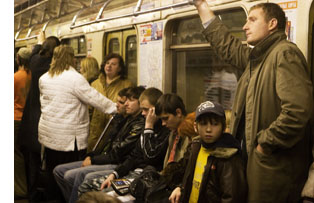 As with all movies about stealing, the pleasure lies in trying to figure out the plan and spot the telltale moves—sort of like the misdirection of a magic act. Here the drama is cunningly contrived. What is Shultes writing in his little brown book? Who is Vasya? What’s his big plan? The plot jumps a level when we realize that all we’ve seen is a flashback, and the ensuing conversation puts things in a startling perspective. Our blankly amoral protagonist even becomes a shade sympathetic. Too rigorous and unemphatic to be an arthouse import, I fear, but ideal for a festival.
As with all movies about stealing, the pleasure lies in trying to figure out the plan and spot the telltale moves—sort of like the misdirection of a magic act. Here the drama is cunningly contrived. What is Shultes writing in his little brown book? Who is Vasya? What’s his big plan? The plot jumps a level when we realize that all we’ve seen is a flashback, and the ensuing conversation puts things in a startling perspective. Our blankly amoral protagonist even becomes a shade sympathetic. Too rigorous and unemphatic to be an arthouse import, I fear, but ideal for a festival.
Shinji Aoyama is best known for Eureka (2000), which won a prize at an earlier Cinédécouvertes. Sad Vacation is one of those films that try to do justice to the ways in which humans become tangled in relationships based on acquaintance, momentary bits of kindness, and sheer chance. Kenji helps smuggle Chinese workers into Japan, but when one dies, Kenji takes the orphan boy under his wing. Soon characters and connections proliferate. There is the salariman and his dumb pal searching for the runaway Kozue. Kenji cares for a slightly daft girl, and he becomes romantically involved with the bargirl Saeko. Accidentally he finds the mother who deserted him, and he joins her new family, complete with mild-mannered father and rebellious brother. Always hovering around are several men and women who work for the father’s trucking company—people rescued, it’s implied, from crime or neglect.
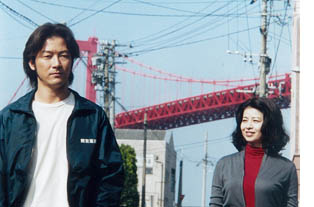 Aoyama manages the crisscrossing relationships delicately, without losing sight of the fact that behind Kenji’s laid-back appearance is a boiling desire to avenge himself on his mother. But she’s his match. A woman of smiling serenity, or smugness, she seems infinitely resilient. The final confrontation of the two, in a prison visiting room, has the giddy sense of one-upmanship of the prison visit in Secret Sunshine. Things turn grim and bleak, yet Sad Vacation manages to feel optimistic without being sentimental; even a flagrantly unrealistic soap bubble at the close seems perfectly in place. I notice that Aoyama has made nearly a film a year since Eureka; why aren’t we (by which I mean, I) seeing them?
Aoyama manages the crisscrossing relationships delicately, without losing sight of the fact that behind Kenji’s laid-back appearance is a boiling desire to avenge himself on his mother. But she’s his match. A woman of smiling serenity, or smugness, she seems infinitely resilient. The final confrontation of the two, in a prison visiting room, has the giddy sense of one-upmanship of the prison visit in Secret Sunshine. Things turn grim and bleak, yet Sad Vacation manages to feel optimistic without being sentimental; even a flagrantly unrealistic soap bubble at the close seems perfectly in place. I notice that Aoyama has made nearly a film a year since Eureka; why aren’t we (by which I mean, I) seeing them?
Some films, like those of Angelopoulos, seem to spit in the face of video. You can’t say you’ve seen them if you haven’t seen them on the big screen. Such was the case with my favorite of the films, The Song of the Birds (El cant dels ocells, 2008) by the Catalan director Albert Serra. It merges an aesthetic out of Straub/ Huillet—black and white, very long static takes, drifts and wisps of action—with a joyous naivete recalling Rossellini’s Little Flowers of St. Francis. Serra’s film also reminded me of Alain Cuny’s L’Annonce fait à Marie (1991) and one of the greatest of biblical films, From the Manger to the Cross (1912). All make modest simplicity their supreme concern.
We three kings of Orient are . . . well, definitely not riding on camels. We are in fact trudging through all kinds of terrain, scrub forests and watery plains and endless desert, to visit the baby Jesus. We are also quarreling about what direction to go, whether to turn back, and why we have to sleep side by side so tightly that our arms go numb. And in an eight-minute take we are struggling up a sand dune, vanishing down the other side, and then staggering up again in the distance.
The three kings aren’t characterized, and they are sometimes unidentifiable in the long-shot framings; only their body contours help pick them out. Intercut with their non-misadventures are glimpses of an angel (whom they may not see) and stretches featuring Joseph and Mary, who caress a lamb. Eventually the infant Himself puts in an appearance, burbling. When the kings finally arrive, one prostrates himself. The image settles into a tidy, unpretentious classical composition and we hear the film’s first burst of music, Pablo Casals’ cello rendering of the folk tune Song of the Birds.
The kings get a chance to bathe in a scummy pool before returning home. Off they trudge. “We’re like slaves!” one complains. In a final shot that would be sheer murk on a DVD, they swap robes and set off in different directions. Did I see them embrace one another? Did they murmur something? I couldn’t tell for sure. Night was falling and they were far away.
Like Casals’ cantata El Pessebre, The Song of the Birds gives us a Catalan nativity. The simplicity is genuine, not faux-naif, and the humility doesn’t preclude humor. Although the shots are quite complex, the spare surface texture invests a familiar story with a plain, shining dignity. Discovering films like this, which you will never see in a theatre and could not bear to watch on video, makes this ambitious festival such a worthy event. It maintains the heritage of one of the world’s great cinema cities.
Next up: A report on films I’m watching at the archive’s vaults on–no kidding–the Rue Gray.
The Metropole, Brussels, 1932.
Thanks to Jean-Paul Dorchain of the Archive for help in finding illustrations. And apologies to readers who came here and found only a stub earlier. An internet gremlin somehow purged the first version of this entry a few hours after it was posted.
Tintin in movieland
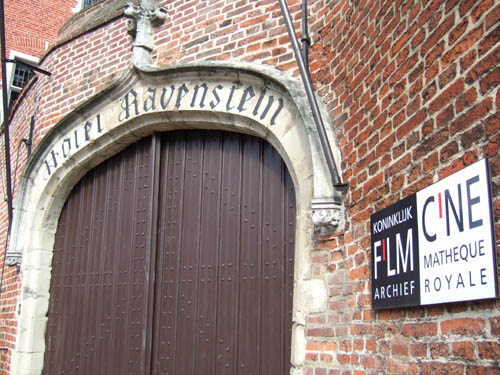
For the number of films you can see on any given day, Brussels gives Paris a run for its money. It also has the advantage of efficiency. Several multiscreen repertory cinemas are within easy walking distance of one another, and normally the Cinémathèque Royale de Belgique programs five different movies per day, plus a rotating program of another ten or so in another venue. For details on these venues, go here.
I’ve heard tales of Parisian cinephiles making the pilgrimage here to see films that their country had banned (e.g., Paths of Glory) or had not released in subtitled versions. I make my own pilgrimage every year, to watch films in the archive and to attend Cinédécouvertes, the annual festival that selects noteworthy items that don’t yet have a local distributor. For fifteen days, three titles are shown each night; you have two chances to see each one. It’s a great way to keep up with films that might not make it to the US or show up only on DVD.
The Cinémathèque, which runs the festival, provides prizes. A jury selects one or two best films, and a cash prize is awarded to a local distributor who agrees to acquire it. There’s also the Prix de l’Age d’or. Named in honor of Buñuel’s scandalous movie, this prize goes to a film that breaks with “cinematic conformism.” Past winners include Carlos Reygadas’ sober and disturbing Japon, Kornel Mundruczo’s frenzied hospital opera Johanna, and Paz Encina’s maximally minimalist Paraguayan Hammock.
The Palais des Beaux Arts is undergoing a huge renovation, and so the original venue, which I’ve visited almost every year for twenty-three years, is shut down.
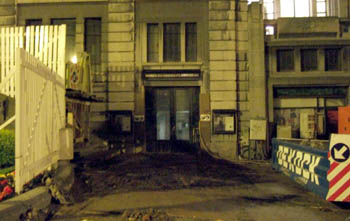
The screenings have moved from this shell of a building to the Shell Building down the street. That location boasts a large foyer done in Postwar Euro Harmless Abstraction.
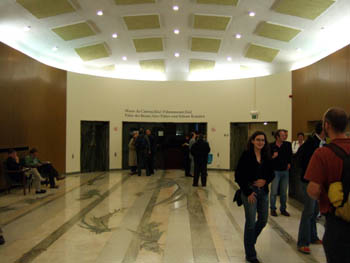
A much bigger venue than the old place, this is a fine auditorium, and attendance has been brisk.
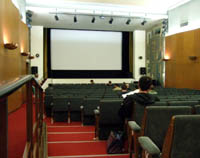

Alas, using only one screen has cut the number of Cinémathèque programs considerably, but next year the renovated Musée will resume its two-screen, heavy-duty schedule. In the meantime, there are always Styx, Nova, Actors Studio, Movy Club, and Cinema Arenberg–with its admirable summer blitz Ecran Total.
A late arrival from Bologna, a heavy archive schedule, and persistent jet lag kept me from several films in the festival, most unhappily Harmony Korine’s Mr. Lonely. Of those I did see….
Shotgun Stories (Jeff Nichols, 2007) A man has two sets of sons by different wives, and the boys start to feud. A laconic US indie, apparently laid back but ready to spring into violence. I liked the unpretentiousness of it; quiet presentation of harsh conflict is often welcome.
The Optimists (Goran Paskaljevic, 2006) Five episodes set in today’s Serbia, with a popular comedian playing a different role in each one. It had that mixture of humor, melancholy, and fatalism that one finds in Eastern European films of the 1960s. A couple of the episodes seemed merely anecdotes, but one, about a crazed little boy taught by his parents to eat anything that appeals to him, is good dirty fun. Some lovely long takes, shot in digital video.
Syndromes and a Century (Apichatpong Weerasethakul, Thailand, 2006) I saw it in Vancouver last fall and couldn’t wait to see it again. Lyrical, finely paced, and unremittingly mysterious. A female doctor works in one clinic, a male one in another (now I get it); beyond that, the connections are teasingly obscure. A parallel-universe movie? A time-travel movie? Two halves of two uncompleted films? Political comment, though oblique, is there as well, most evident in a stockpile of artificial limbs in a hospital basement, adjacent to the military wing.
Mogari Forest (Kawase Naomi, Japan, 2007) Speaking of mystery, it’s ladled on pretty heavily in this Cannes Grand Prize winner. A woman working with the elderly in a care facility follows an old man into the forest; epiphany occurs. I have liked, mildly, Kawase’s earlier films Suzaku and Shara, but this one felt a little heavy-handed in its appeal to elemental forces. Still, the rhythm is engrossing, and it’s remarkably tactile, making you feel the dampness of loam and ferns.
Blue Eyelids (Ernesto Contreras, Mexico, 2007) At first I thought I was seeing a likable but unambitious commercial film about two lonely souls brought together. Then things slip sideways. A shy working woman wins a vacation trip for two, but she doesn’t really know anybody to ask along. She meets a former schoolmate and invites him. As they prepare for their holiday, their relationship becomes freighted with emotional investments. Nicely managed shifts in point of view both reveal and hide key information, and we get fine performances. But was the bird symbolism really necessary?
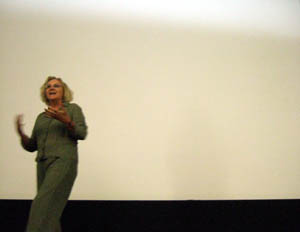
This year’s winners were Mogari Forest and Hotel Very Welcome (Sonja Heiss, Germany) for best films (10,000 euros each) and La influencia (Pedro Aguilera, Spain/ Mexico) for the L’age d’or prize (5,000 euros). Above, Cinémathèque director Gabrielle Claes introduces the jury.
Next time: Visiting the archive and checking out local cinemas (at last I catch Inland Empire). Maybe some beer as well.
